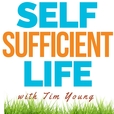Season 1: Episode 16: Moving to a New Homestead with Tim & Liz Young|Farming | Homesteading [PODCAST]

Summary: If you had an opportunity to opt out of the rat race and set up a modern homestead, how would you go about it? This week you’ll hear my wife Liz and I share our step-by-step process for choosing our new homestead location.<br> <br> Welcome to Episode 16 of Self-Sufficient Life! This week’s episode is a little different in that it doesn’t profile another homesteader or farmer. Instead, it begins the process of profiling us. By that I mean my wife, Liz, and myself, and the life of modern homesteading that we’re enjoying.<br> <br> Now, many of you have followed our journey since we left the rat race, back in 2006.<br> <br> You read the farm blog we maintained years ago. And bout a quarter million of you listened to our podcasts from 2010-2012, many from all corners of the world. And tens of thousands more have read my books, most notably The Accidental Farmers and How to Make Money Homesteading.<br> <br> Still, many of you are unacquainted with our story.<br> <br> In a nutshell, we lived in suburban Atlanta in 2006, on a golf course with a strict HOA. We’d never farmed, but that didn’t stop us from buying over 120 acres in rural Georgia, leaving behind our careers in corporate America and teaching to become first-generation farmers.<br> <br> We raised pretty much anything that walks. Grassfed beef, meat chickens, laying hens, rabbits, pigs, geese, ducks, dairy cows and, just for fun, donkeys, guineas and guardian dogs. We built a great customer base from Atlanta to Athens, GA, and loved hosting farm tours for up to 100 people a month.<br> <br> And then—we sort of went into seclusion in late 2012. We stopped blogging and podcasting, though we continued farming through 2015, selling grassfed meats and farmstead cheese.<br> <br> But in 2015 we stopped farming commercially and began the process of migrating from being farmers to being homesteaders.<br> <br> This is a story of what to look for in a modern homestead property.<br> <br> homestead incomeLiz and I spent a couple of years searching for a new homestead property, as we transitioned from being commercial farmers (for others) to homesteaders.<br> <br> Of course, the process took longer than we wanted, as we had to sell off farm animals and a farm business. We discuss how we handled that in this episode, as well as the reasons that drove us from farming to homesteading.<br> <br> Once we completed those tasks, we still had to find a new homestead. We wanted this to be a very long-term move, if not for life, so we established a series of criteria in looking for a new homestead.<br> <br> Those criteria included:<br> <br> 1) macro criteria for new property<br> <br> incurring no debt / strict budget<br> proximity to family<br> slightly cooler garden zone<br> southern exposure<br> higher elevation<br> rainfall<br> low taxes<br> low/no restrictions on building codes<br> state friendly to homeschool<br> 2) micro criteria for new property<br> <br> mature fruit trees<br> at least 20 acres, unless on a mountain<br> good well water or gravity water/water on property (pond, mountain stream, springs)<br> no sight of paved road<br> no sight of neighbors<br> good hunting/foraging<br> much smaller house<br> ideally heated with wood<br> pasture, but no more than a few acres<br> within an hour of sizable town, 30 mins of grocery store/hospital<br> around like minded-people (homeschool groups, homesteading culture, farming, etc.)<br> 3) things we knew weren’t critical<br> <br> school system<br> fencing<br> high quality pasture<br> outbuildings<br> existing garden (because we’d be putting in raised beds)<br> cosmetics on house…just well insulated and sound<br> Liz and I discuss all these criteria in detail as well as the life of farming versus homesteading. So grab some coffee and pull up a chair!<br>
